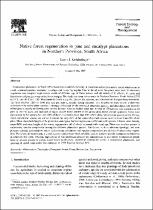 ResearchSpace
ResearchSpace
Native forest generation in pine and eucalypt plantation in Northern Province, South Africa
JavaScript is disabled for your browser. Some features of this site may not work without it.
- ResearchSpace
- →
- Research Publications/Outputs
- →
- Journal Articles
- →
- View Item
| dc.contributor.author |
Geldenhuys, CJ

|
en_US |
| dc.date.accessioned | 2007-02-08T06:47:16Z | en_US |
| dc.date.accessioned | 2007-06-07T10:06:38Z | |
| dc.date.available | 2007-02-08T06:47:16Z | en_US |
| dc.date.available | 2007-06-07T10:06:38Z | |
| dc.date.copyright | en_US | |
| dc.date.issued | 1997-12 | en_US |
| dc.identifier.citation | Geldenhuys, CJ. 1997. Native forest generation in pine and eucalypt plantation in Northern Province, South Africa. Forest Ecology and management, vol 99, 2 January, pp 101-115 | en_US |
| dc.identifier.issn | 0378-1127 | en_US |
| dc.identifier.uri | http://hdl.handle.net/10204/1626 | en_US |
| dc.identifier.uri | http://hdl.handle.net/10204/1626 | |
| dc.description.abstract | Commercial plantations in South Africa have been established mainly in grasslands adjacent to native forest which occur as small, scattered patches, restricted to valleys and scarps by regular fire-prone grasslands. Under storey vegetation was sampled in plantation stands of different age Pinus patula, and old stands of P. elliottii, P. taeda and Eucalyptus saligna, growing on the forest margin. The study was done in two areas in Northern Province in South Africa: Woodbush-DE Hoek along the Eastern escarpment, and Entabeni on Soutpansberg Mountains. The area receives 1200 to 1900 mm rain per annum, mainly during summer. Two hypotheses were tested: under storey colonisation by native plant species is strongly influenced by the overhead plantation species; and abundance and diversity of indigenous woody and herbaceous species increase with increasing stand age. A total of 170 species were recorded on 62 plots of 78.5m (2) each, and included all major growth forms present in the forest, except Epiphytes. The results demonstrate a useful succession process forest, could be used to achieve specific management objectives at relatively low costs. Potential applications of this succession process are manipulation of tree stands (Commercial plantation or invader plants) to restore native forest biodiversity, control of under storey weeds in commercial plantation, and growing of useful crops under tree canopies. | en_US |
| dc.format.extent | 969484 bytes | en_US |
| dc.format.mimetype | application/pdf | en_US |
| dc.language.iso | en | en_US |
| dc.publisher | Elsevier Science BV | en_US |
| dc.rights | Copyright: 1997 Elsevier Science BV | en_US |
| dc.source | en_US | |
| dc.subject | Afforestation | en_US |
| dc.subject | Eucalyptus | en_US |
| dc.subject | Evergreen foretsts | en_US |
| dc.subject | Pinus | en_US |
| dc.subject | Restoration - Native forest biodiversity | en_US |
| dc.title | Native forest generation in pine and eucalypt plantation in Northern Province, South Africa | en_US |
| dc.type | Article | en_US |
| dc.identifier.apacitation | Geldenhuys, C. (1997). Native forest generation in pine and eucalypt plantation in Northern Province, South Africa. http://hdl.handle.net/10204/1626 | en_ZA |
| dc.identifier.chicagocitation | Geldenhuys, CJ "Native forest generation in pine and eucalypt plantation in Northern Province, South Africa." (1997) http://hdl.handle.net/10204/1626 | en_ZA |
| dc.identifier.vancouvercitation | Geldenhuys C. Native forest generation in pine and eucalypt plantation in Northern Province, South Africa. 1997; http://hdl.handle.net/10204/1626. | en_ZA |
| dc.identifier.ris | TY - Article AU - Geldenhuys, CJ AB - Commercial plantations in South Africa have been established mainly in grasslands adjacent to native forest which occur as small, scattered patches, restricted to valleys and scarps by regular fire-prone grasslands. Under storey vegetation was sampled in plantation stands of different age Pinus patula, and old stands of P. elliottii, P. taeda and Eucalyptus saligna, growing on the forest margin. The study was done in two areas in Northern Province in South Africa: Woodbush-DE Hoek along the Eastern escarpment, and Entabeni on Soutpansberg Mountains. The area receives 1200 to 1900 mm rain per annum, mainly during summer. Two hypotheses were tested: under storey colonisation by native plant species is strongly influenced by the overhead plantation species; and abundance and diversity of indigenous woody and herbaceous species increase with increasing stand age. A total of 170 species were recorded on 62 plots of 78.5m (2) each, and included all major growth forms present in the forest, except Epiphytes. The results demonstrate a useful succession process forest, could be used to achieve specific management objectives at relatively low costs. Potential applications of this succession process are manipulation of tree stands (Commercial plantation or invader plants) to restore native forest biodiversity, control of under storey weeds in commercial plantation, and growing of useful crops under tree canopies. DA - 1997-12 DB - ResearchSpace DP - CSIR KW - Afforestation KW - Eucalyptus KW - Evergreen foretsts KW - Pinus KW - Restoration - Native forest biodiversity LK - https://researchspace.csir.co.za PY - 1997 SM - 0378-1127 T1 - Native forest generation in pine and eucalypt plantation in Northern Province, South Africa TI - Native forest generation in pine and eucalypt plantation in Northern Province, South Africa UR - http://hdl.handle.net/10204/1626 ER - | en_ZA |





